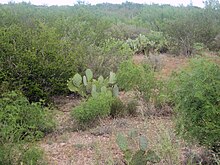Shrubland,scrubland,scrub,brush,orbushis aplant communitycharacterized byvegetationdominatedbyshrubs,often also includinggrasses,herbs,andgeophytes.Shrubland may either occur naturally or be the result of human activity. It may be the maturevegetation typein a particular region and remain stable over time, or a transitional community that occurs temporarily as the result of a disturbance, such as fire. A stable state may be maintained by regular natural disturbance such as fire orbrowsing.Shrubland may be unsuitable for human habitation because of the danger of fire. The term was coined in 1903.[1]



Shrubland species generally show a wide range ofadaptationsto fire, such as heavy seed production,lignotubers,and fire-induced germination.[2]
Botanical structural form
editInbotanyandecologya shrub is defined as a much-branchedwoody plantless than 8 m high and usually with manystems.Tall shrubs are mostly 2–8 m high, small shrubs 1–2 m high andsubshrubsless than 1 m high.[3]
There is a descriptive system widely adopted inAustraliato describe different types of vegetation is based onstructural characteristicsbased onplant life-form,plus the height and foliage cover of the tallest stratum ordominantspecies.[4]
For shrubs that are 2–8 metres (6.6–26.2 ft) high, the following structural forms are categorized:
- dense foliage cover (70–100%) —closed-shrubs
- mid-dense foliage cover (30–70%) —open-shrubs
- sparse foliage cover (10–30%) —tall shrubland
- very sparse foliage cover (<10%) —tall open shrubland
For shrubs less than 2 metres (6.6 ft) high, the following structural forms are categorized:
- dense foliage cover (70–100%) —closed-heathorclosed low shrubland—(North America)
- mid-dense foliage cover (30–70%) —open-heathormid-dense low shrubland—(North America)
- sparse foliage cover (10–30%) —low shrubland
- very sparse foliage cover (<10%) —low open shrubland
Biome plant group
editSimilarly, shrubland is a category used to describe a type ofbiomeplant group. In this context, shrublands are dense thickets of evergreensclerophyllshrubs and small trees,[5]called:
- ChaparralinCalifornia
- MatorralinChile,Mexico,andSpain
- MaquisinFranceand elsewhere around theMediterranean
- MacchiainItaly
- FynbosinSouth Africa
- Eastern Suburbs Banksia ScrubinSydney
- Kwonganin SouthwestAustralia
- Cedar scrubinTexas Hill Country
- Caatingain northeastern Brazil
In some places, shrubland is the mature vegetation type, and in other places, the result of degradation of formerforestorwoodlandbyloggingorovergrazing,or disturbance by major fires.[citation needed]
A number ofWorld Wildlife Fundbiomes are characterized as shrublands, including:[6][7]
- Desert scrublands
Xericordesert scrublandsoccur in the world'sdeserts and xeric shrublandsecoregions or in fast-draining sandy soils in more humid regions. These scrublands are characterized by plants with adaptations to the dry climate, which include small leaves to limit water loss, thorns to protect them from grazing animals, succulent leaves or stems,storage organsto store water, and long taproots to reach groundwater.[6]
- Mediterranean scrublands
Mediterranean scrublandsoccur naturally in theMediterranean scrubbiome,located in the fiveMediterranean climateregions of the world. Scrublands are most common near the seacoast and have often adapted to the wind and salt air of the ocean. Low, soft-leaved scrublands around theMediterranean Basinare known asgarrigueinFrance,phryganainGreece,tomillaresinSpain,andbathainIsrael.Northern coastal scrubandcoastal sage scruboccur along theCaliforniacoast,strandveldin theWestern CapeofSouth Africa,coastal matorral incentral Chile,and sand-heath andkwonganinSouthwest Australia.[7]
- Interior scrublands
Interior scrublandsoccur naturally in semi-arid areas where soils are nutrient-poor, such as on thematasofPortugal,which are underlain byCambrianandSilurianschists.Florida scrubis another example of interior scrublands.
- Dwarf shrubs
Some vegetation types are formed ofdwarf-shrubs:low-growing or creeping shrubs. These include themaquisandgarriguesof Mediterranean climates and the acid-loving dwarf shrubs ofheathlandandmoorland.
See also
editNotes and references
edit- ^Merriam-Webster's Collegiate Dictionary, 11th Edition (2003).
- ^Mares, Michael S., ed. (1999)."Fire".Encyclopedia of deserts.University of Oklahoma Press. p. 215.ISBN978-0-8061-3146-7.
- ^Flora of New South Wales,Vol.4 ed. Gwen J. Harden, Royal Botanic Gardens, SydneyISBN0-86840-188-9
- ^Costermans, L. F. (1993)Native trees and shrubs of South-Eastern Australia.rev. ed.ISBN0-947116-76-1
- ^Woodward, Susan."Mediterranean Shrublands".Geography 235.Radford University.Retrieved7 October2010.
- ^ab"Deserts and Xeric Shrublands".World Wildlife Fund.Archived fromthe originalon 2 January 2011.Retrieved7 October2010.
- ^ab"Mediterranean Forests, Woodlands and Scrub".World Wildlife Fund.Archived fromthe originalon 11 January 2017.Retrieved7 October2010.
External links
edit- Media related toShrublandsat Wikimedia Commons